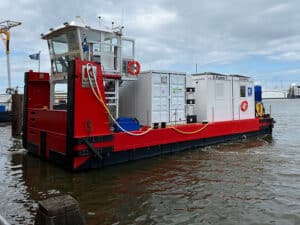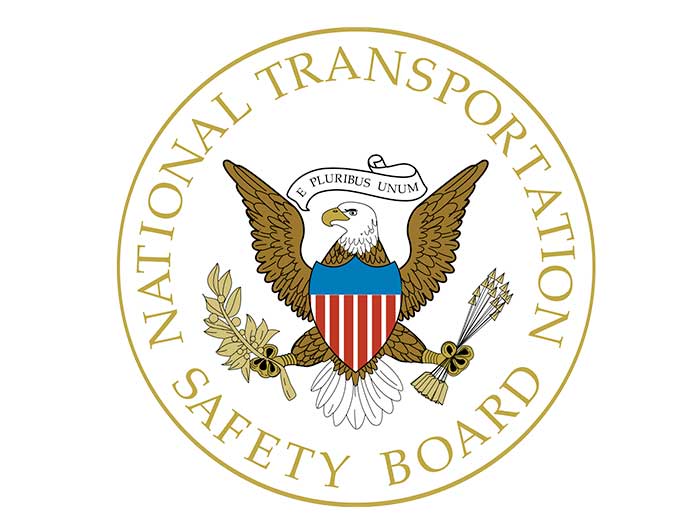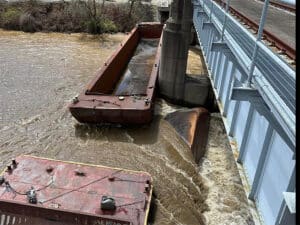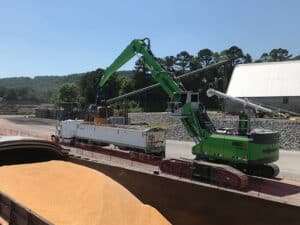
NTSB cites “lack of effective maintenance program” in 58-year old towboat involved in collision
Written by Nick Blenkey
Image: NTSB
The National Transportation Safety Board has issued its report on a February 13, 2019, incident in which, transiting downbound on the Lower Mississippi River, the 1961-built towing vessel Miss Dixie (owned by Hex Stone and operated by JRC Marine), collided with the 1976-built upbound towing vessel D.& R. Boney (owned by American Commercial Barge Line and operated by Inland Marine Service) which was pushing nine barges.
Several barges broke loose from their tows and were subsequently gathered up by the crews of the towing vessels. No injuries or pollution were reported. The cost of damages to four barges was $294,530.
Initially, says the NTSB report, the Miss Dixie’s downbound transit proceeded as expected; no issues with any machinery or equipment were reported.
Things started to go wrong after the Miss Dixie passed under the Huey Long Bridge and was lined up to meet two northbound tows: the Mary Parker and the D.& R. Boney. The Miss Dixie’s captain had arranged to meet the Mary Parker starboard to starboard but had not communicated with the D.& R. Boney.
“At 1915, after passing the Mary Parker near mile 104,” says the report, “the Miss Dixie’s captain noticed that the vessel was not responding to his steering and propulsion commands and he was unable to execute the sharp turn as expected. About this time, a deckhand saw smoke in the engine room and reported that there was a fire in the engine room in the area of the port clutch. The captain rang the general alarm, contacted the D.& R. Boney, and requested to meet the upbound vessel on “the one whistle,” meaning that the vessels would pass each other port side to port side. The captain of the D.& R. Boney repeated the request and said, “it don’t look good for that,” and, “I sure wish you’d go for the two, but all right, I’ll shoot her over.” Five seconds later, the D.& R. Boney’s captain said that he was going to stop his vessel because the vessels would collide if they attempted to meet port side to port side. Fifteen seconds later, the D.& R. Boney’s captain took evasive action and broadcast that he was “backing like hell” (meaning his engines were at maximum astern). About this time, the deckhands aboard the Miss Dixie returned to the engine room with a fire extinguisher and searched for the source of the fire. After finding no flames, the deckhands ventilated the space to clear the smoke by opening the engine room doors and then vacated the space. None of the crew reported hearing any fire or smoke alarms during the incident.”
At 1917, says the report, the captain of the Miss Dixie broadcast over VHF that he had “lost an engine,” and about 30 seconds afterwards, the lead barge in the Miss Dixie’s tow collided with the lead barge of the D.& R. Boney’s tow, bringing the tows to a stop, breaking securing wires, and releasing several barges adrift into the river. Shortly afterwards, the Miss Dixie’s captain announced over VHF that there was a fire in the engine room. Immediately after the collision, the Coast Guard VTS contacted nearby vessels to assist and subsequently closed the river at 1922 between miles 101 and 106. Shortly afterwards, the deckhand reported to the captain that there was no fire in the engine room, and the port clutch had “burned up.”
After the collision, the crew of the Miss Dixie determined that the port clutch was the source of the smoke. After the accident, a service representative specializing in marine industrial gears inspected the port clutch aboard the Miss Dixie and determined that the port clutch had “excessive wear” and that the clutch would slip and was “40% operational.”
According to the owner of the Miss Dixie’s operating company, the vessel was acquired about six months before the accident. The owner indicated that a purchase survey was completed and that the maintenance records came with the vessel. Prior to acquiring the vessel, both main engines were overhauled, but he did not know if this overhaul included the clutches. After the overhaul and before the purchase of Miss Dixie, the engines had been operated for 40 hours. He believed that the clutches were inspected, was told that they were in “good standing,” and did not believe that it was necessary to rebuild them. He was not aware of the maintenance requirements and periodic inspections for the type of clutches aboard Miss Dixie. When asked about a preventive maintenance system for the vessel, the owner stated that the crews performed daily visual checks on the machinery, and if any issues were detected that exceeded the ability of the crew to address, outside vendors would be hired to effect repairs. Additionally, none of the vessels in the fleet had yet to be inspected under 46 Code of Federal Regulations (CFR) Subchapter M.
The owner did not provide any maintenance records to investigators.
According to the vessel operator, the clutch manufacturer’s instructions for periodic inspections were not aboard the vessel.
INVOLVED IN TWO MORE CASUALTIES
The Miss Dixie was involved in two other casualties in the weeks after the collision with the D.& R. Boney tow. Ten days after, while pushing three barges, the tow of the Miss Dixie struck a stationary barge near New Orleans. Two weeks later, the Miss Dixie experienced a crankcase explosion in the starboard engine, causing a fire in the engine room. After the fire was extinguished, the Miss Dixie was towed to shore. On March 3, 2019 the Miss Dixie was removed from active service and subsequently scrapped.
PROBABLE CAUSE
The National Transportation Safety Board determined that the probable cause of the collision between the tows of the towing vessels Miss Dixie and D.& R. Boney was the lack of an effective maintenance program aboard the Miss Dixie, resulting in excessive and undetected wear of the port clutch, which compromised the vessel’s maneuverability.
The NTSB report concludes with this caution:
INSPECTION OF PROPULSION SYSTEM CLUTCH ASSEMBLIES
Owners and operators should ensure that all critical equipment associated with propulsion systems, such as clutches, are included in preventative maintenance systems and that they follow the manufacturer’s maintenance and inspection interval recommendations.
Download the report HERE




